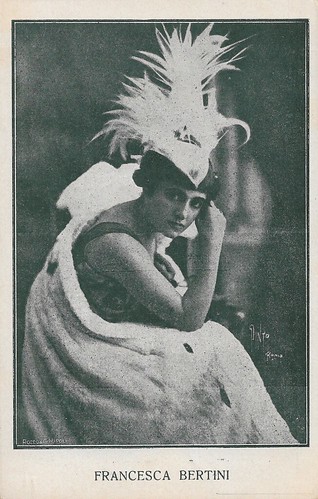
Italian postcard by Caesar Film for the magazine Film, Naples / Rome. Photo: Roseo & Co., Naples.
During the first quarter of the twentieth century, Francesca Bertini (1892-1985) was a majestic diva of the Italian silent cinema. She often played the 'femme fatale', with men devouring eyes, glamorous attire, clenched fists, and in opulent settings... She starred in the film Caesar production Andreina (Gustavo Serena, 1917).

Italian postcard by Caesar Film for the magazine Film, Naples / Rome. Photo: Roseo & Co., Naples.
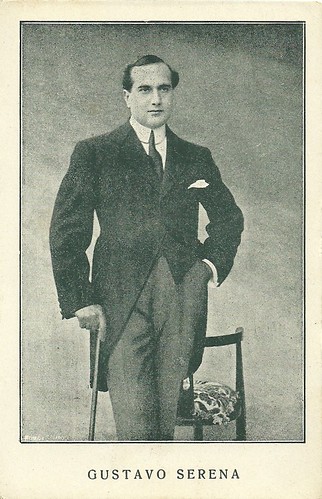
Italian postcard by Caesar Film for the magazine Film, Naples / Rome. Photo: Roseo & Co., Naples.
Italian actor Gustavo Serena (1882-1970) is most remembered as Francesca Bertini's co-star, but he did more than that. For Caesar Film, he directed and acted in the films La cieca di Sorrento (1916), Andreina (1917), and Fernanda (1917).
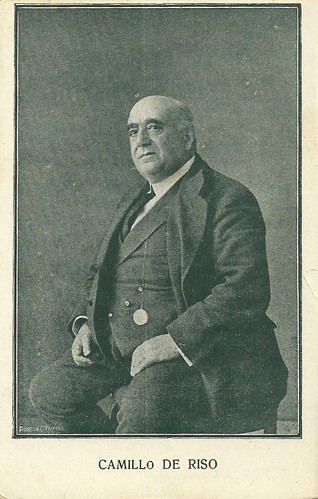
Italian postcard by Magazine Film, Napoli/Roma. Photo: Roseo & Co, Naples / Caesar Film.
Camillo De Riso (1854-1924) was an Italian actor and director of the Italian stage and screen, most famous for his comic acting and directing at the companies Ambrosio, Gloria, and Caesar. He appeared in Caesar's Andreina (Gustavo Serena, 1917).
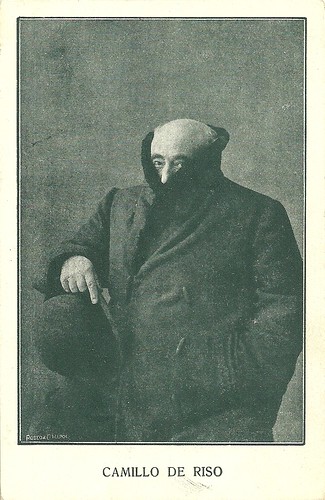
Italian postcard by Magazine Film, Napoli/Roma. Photo: Roseo & Co, Naples / Caesar Film.
Caesar Film
Caesar Film was an Italian film production and distribution company that was initially active during silent cinema from 1914 to 1919, and until 1925 if the U.C.I. period is also considered. During these years it became one of the main production companies, involving many of the most important directors and actors of the time and linking its name in particular with diva Francesca Bertini. Later on, it was relaunched at the beginning of sound cinema for the second period of activity that lasted from 1931 to 1935.
Caesar was born from the transformation of a company founded in October 1913 by three pioneers in the film industry. The first two, Gualtiero Giomini and Augusto Panella, were owners of a small production company located in Albano Laziale, Tebro Film, of which only one film is known to have been produced in 1912. The third pioneer, Giuseppe Barattolo, had already been active for some time in the distribution and rental sector with considerable success. he had an agreement with five US production companies, Biograph, Essanay, Kalem, Lubin, and Selig, to import their films into Italy. At the time of its foundation, the company was called 'Società anonima Barattolo, Giomini & Panella'.
The founders' intention was to be part of the golden age of Italian cinema in the first half of the 1910s, which, with its 'colossal' productions of historical films. This development guaranteed substantial income from the export of Italian films, so much so that in the years leading up to Italy's entry into the war the trade in Italian films reached the considerable sum of 40 million gold lire.
Soon the company changed its name, becoming 'Caesar Film' in the early months of 1914. Barattolo remained its only manager and the production programmes began to appear, while the plants located in the Circonvallazione Appia, at that time the Via Zaccaria in Rome, were completed. Emilio Ghione became the company's artistic director. But in 1914, the first year of activity, in the absence of an artistic cast, only two documentaries were produced.
The company really took off at the beginning of 1915, when Barattolo managed to recruit a group of actors mostly from Celio Film. In the following months, he recruited more actors and directors, including Gustavo Serena and Camillo De Riso. But the most important acquisition was that of Francesca Bertini, who had already established herself at Tiber film. Bertini opened her season at Caesar with Nelly la gigolette/Nelly the gigolette (Emilio Ghione, 1915), successfully creating a figure of a beautiful and independent woman.
In the second half of 1914, the beginning of the war in Europe had led to the closure or reduction of activity of most production companies, even though Italy was still not involved. Caesar went against the tide and Barattolo increased production. He relied on the rising stardom of Bertini, who became one of the grand divas of the silent Italian cinema.
When Italy entered the war in 1915, Caesar gave very little space to patriotic works and hired several filmmakers who had lost their jobs due to the war. These included Roberto Roberti, who would become Bertini's trusted director, and Arrigo Frusta, who until then had been the main author of subjects for Ambrosio in Turin. During the war period, Caesar and Tiber (later Itala Film) remained the two major Italian film companies. There would be various legal disputes between the two companies. The first and best-known dispute concerned 'Signora delle camelie' (The Lady of the Camellias), Alexandre Dumas's novel of which two Italian film adaptations were made at the same time, directed by Gustavo Serena (for Caesar) and Baldassarre Negroni (for Tiber).
During the war years, Caesar produced about 80 films, including many Bertini productions, or comedies with Polidor and Camillo De Riso. Caesar also secured the collaboration of another great actress, until then applauded mainly in the theatre, Vera Vergani. After the war, Italian cinema suffered under the import of Hollywood productions, but also by its own inability to renew itself, and went into crisis. Barattolo became the architect of the constitution of the UCI, which gradually brought together the main production companies in the conviction that a trust of Italian companies could counteract the American dominance of the market. Caesar was of course one of the first companies to join the Union in 1919.

Italian postcard by Magazine Film, Napoli/Roma. Photo: Roseo & Co, Naples / Caesar Film.
Carlo Benetti (1885-1958) was an actor in Italian silent cinema. He married Olga Benetti (?-1958) and both made their film debut in 1912 at the Cines company. Important were Olga Benetti's roles as the antagonist in the Francesca Bertini dramas, such as in Caesar's Andreina (Gustavo Serena, 1917), in which Carlo also acted.

Italian postcard by Magazine Film, Napoli/Roma. Photo: Roseo & Co, Naples / Caesar Film.

Italian postcard by Magazine Film, Napoli/Roma. Photo: Roseo & Co, Naples / Caesar Film. Collection: Joseph North.
Lea Giunchi (1884-?) was the first comical actress in Italian cinema, acting either in her own 'Lea' series, or with male comedians such as Ferdinand Guillaume (Tontolini) and Raymond Frau (Kri Kri). She also played in the Italian silent epic Quo vadis? (1913),and in the Caesar production La cieca di Sorrento (Gustavo Serena, 1916).

Italian postcard by Magazine Film, Napoli/Roma. Photo: Roseo & Co, Naples / Caesar Film.
Little is known about Italian actor Alfredo Cruicchi (?-?), who debuted at Caesar Film as the American impresario Barnum in the Francesca Bertini vehicle Andreina (Gustavo Serena, 1917). Afterward, he acted in the Caesar serial Mademoiselle Monte Cristo (Camillo De Riso, 1918), starring Tilde Kassay. In the early 1920s he did two more films, La sconosciuta (Bianca Virginia Camagni, Tito Spagnol, 1921) with Camagni in the lead, and produced by Camagni too, and Il grido dell'aquila (Mario Volpe, 1923).

Italian postcard by Magazine Film, Napoli/Roma. Photo: Roseo & Co, Naples / Caesar Film.
Giovanni Gizzi (?-?) was an actor on the Italian silent screen. After his role as Peter in Quo vadis? (Enrico Guazzoni, 1913), he became a regular supporting actor at Caesar Film in such films as Andreina (Gustavo Serena, 1917).

Italian postcard by Magazine Film, Napoli/Roma. Photo: Roseo & Co, Naples / Caesar Film.
Vittorio Bianchi (1865-?) was an actor and screenwriter of the Italian silent screen. In 1916, he became one of the regular supporting actors at Caesar Film, first in Ferréol (Edoardo Bencivenga, 1916). He then acted in a range of dramas with diva Francesca Bertini: Fedora (Giuseppe de Liguoro, Gustavo Serena, 1916), Andreina (Gustavo Serena, 1917), Tosca (Alfredo De Antoni, 1918), La lussuria (Bencivenga, 1919), La contessa Sara (Roberto Roberti, 1919), and La serpe (Roberti, 1920). For La lussuria and La serpe, he was also the screenwriter. At Caesar he also acted in other films such as Le due orfanelle (Bencivenga, 1918), Maman Colibri (De Antoni, 1918) with Tilde Teldi, Dora o Le spie ((Roberti, 1919) with Vera Vergani, La morte civile (Bencivenga, 1919), Il cuore sotto il maggio (Camillo De Riso, 1920), Fino alla tenebra (Bencivenga, 1920), etc. Often these films were society dramas based on French plays by Victorien Sardou and others. His last films at Caesar, Bianchi did in 1921.
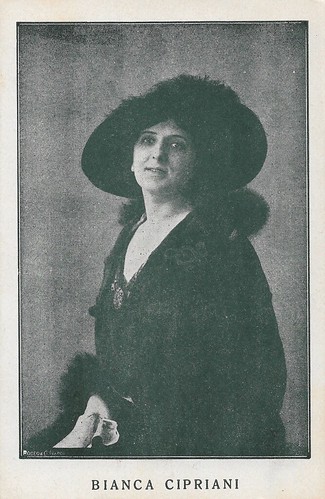
Italian postcard by Magazine Film, Napoli/Roma. Photo: Roseo & Co, Naples / Caesar Film.
Little is known about Italian silent film actress Bianca Cipriani. She was mainly a stage actress, who first acted in two films by the Roman company Latium Film. In 1915, after some 190 films, Latium Film closed down its production. It may have been the reason for Cipriani to move to the Roman company Caesar Film, where she acted in La cieca di Sorrento (Gustavo Serena, 1916), adapted from the novel of Francesco Mastriani. The plot of the film deals with the inmate of a prisoner condemned to death for murder. The inmate, Gianni (Serena), takes care of the latter's son, Gaetano. The son emigrates and returns a famous oculist. He will heal the eyes of the daughter of the murdered man (Lea Giunchi), with the help of Gianni - who fights the girl's greedy aunt (her warden) and the second murderer of her father. It is not clear which part Cipriani played. After this film, Cipriani's career in the cinema was over.

Italian postcard by Magazine Film, Napoli/Roma. Photo: Roseo & Co, Naples / Caesar Film.
Olga Vannelli may have been a Neapolitan actress, as her film debut was at the company Napoli Film, in Promozione per... meriti personali (Oreste Gherardini, 1914). In 1917 she acted in two films at Caesar Film in Rome, first in the D'Annunzio adaptation La figlia di Jorio (Edoardo Bencivenga, 1917) starring Mario Bonnard as Aligi and Irene Saffo Momo as Mila di Codro. Vannelli played Vanda, the wife. Next was the Sardou adaptation Fernanda (Gustavo Serena, 1917) with Leda Gys and Serena himself. Vannelli played Gys' mother, who tries to survive accepts to run a gambling house but is arrested and imprisoned when her daughter (Gys) refuses the avances of a crook, Roqueville (Orlando Ricci). Vannelli's last part was in Serena's film L'albergo nero (1920), a Caesar production also with Serena and Thea (Teresa Termini). The film was already produced in 1916 but was released four years after. Censorship may have been the cause one critic thought the film incomprehensible. Vannelli played a mother who plans to rob the man who saved her son and accidentally kills her son. Nothing more is known about the life and career of Olga Vannelli.
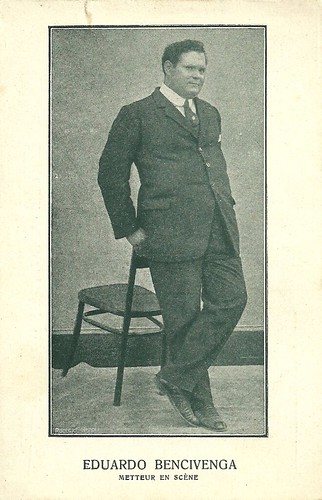
Italian postcard by Magazine Film, Napoli/Roma. Photo: Roseo & Co, Naples / Caesar Film.
Italian film director Edoardo Bencivenga (1885-1934) was one of the most active film directors in Italian silent cinema. In 1907, he entered Alberini's film company Cines, directing Raffaello e la Fornarina. In 1910-1911, he worked in Turin, first mostly at Aquila where he was responsible for its major successes, then in 1911 at Savoia and in 1912 at Ambrosio. At Ambrosio he directed e.g. a series of short D'Annunzio adaptations and an impressive feature, L'epopea napoleonica (1913-14). In 1915 he did a few patriotic films at Polifilms in Naples, after which in 1916 he entered the Roman Caesar Film company where he worked for several years. He directed a few films with Mario Bonnard such as Ferréol (1916), and Don Giovanni (1916). Then he did the D'Annunzio adaptation La figlia di Jorio (1917) with Bonnard and Irene-Saffo Momo, and the serial Le due orfanelle (1918) with Enna Saredo. He also directed many films with the Italian diva Francesca Bertini, including several episodes of the series I sette peccati capitali as well as Mariute (1918) and La piovra (1919). From the late 1910s, Bencivenga worked for various companies, in films with Enna Saredo, Gemma Bellincioni, and Elena Sangro. All in all, Bencivenga directed over 65 films.
Sources: Wikipedia (Italian), and IMDb.
No comments:
Post a Comment